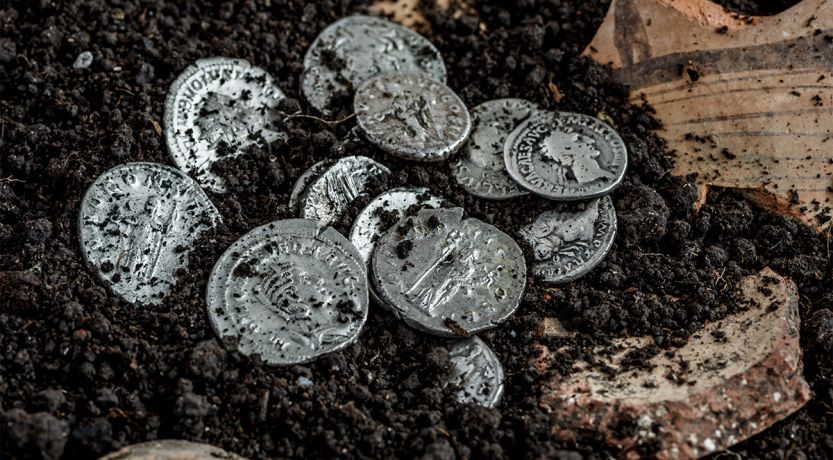Jesus’ confrontation with the moneychangers in the temple is well-known. But why did He cleanse the temple? What can we learn from His actions?
After the wedding in Cana, Jesus traveled south to Jerusalem to observe the Passover festival. But this trip to Jerusalem would be anything but routine.
Upon entering the temple complex, He encountered a disturbing scene. Instead of seeing a place of dignified worship, He found the outer court of the temple being used as a livestock market and for currency exchange.
What was happening and how did Jesus react to it? What can we learn from His reaction?
What exactly was happening at the temple?
Here’s how John described the scene: “And He found in the temple those who sold oxen and sheep and doves, and the money changers doing business” (John 2:14).
Why were they selling animals?
When people visited the temple, they would bring animals for the priests to sacrifice on their behalf (as outlined in Leviticus 1).
Those who traveled from far distances or didn’t own animals would have to purchase an animal in Jerusalem in order to offer a sacrifice.
That wasn’t a problem. The problem was how and where this was being done.
A corrupt system in the temple
The temple was run by the priests. These leaders had put in place a corrupt system that benefited themselves and the vendors.
The priests justified this system by using the biblical requirement that the animals be “without blemish” (Leviticus 1:3, 10). People could be assured that their offering would be accepted only by buying an animal that was already inspected (certified, if you will) from a temple vendor.
This gave the temple vendors a virtual monopoly on sacrificial animals, allowing them to hyperinflate the prices and exploit the people. A portion of these profits was finding its way into the priests’ pockets.
Why were moneychangers in the temple?
To make the matter worse, only a certain kind of currency was accepted in the temple. This was done based on Exodus 30:13-16, which specified using shekels in the sanctuary. It was also probably done in the name of keeping the temple undefiled by Roman coins, which bore the images of emperors or gods.
But, in actuality, the system was rigged for profit.
When travelers entered the temple complex, they had to pay the moneychangers “exorbitant exchange rates” to trade their Roman coins for temple coins (The New Bible Commentary: Revised, p. 935). This enriched the moneychangers and, undoubtedly, the priests as well.
Disrespect toward the gentiles
Herod’s temple complex had courtyards for different groups of people. Closest to the temple was a courtyard for the priests. Outward from that were courtyards for men of Israel, for women of Israel, and for gentiles. Because the courtyard of the gentiles was accessible to everyone, it was the biggest and busiest part of the temple.
So the animal marketplace was set up in this area.
This was a statement of how little the Jewish authorities valued gentile worshippers and even God’s purpose for the temple. The priests and Jewish vendors had no qualms about making the gentiles’ courtyard into a chaotic marketplace—filled with all the sights, sounds and smells of animals and all the chatter and racket of commerce.
It was a visual representation of how little they thought of everyone who wasn’t Israelite by blood.
(More historical details about the temple and the court of the gentiles can be found in chapter 4 of Merrill Tenney’s New Testament Survey and in book 3, chapter 5 of Alfred Edersheim’s The Life and Times of Jesus the Messiah.)
Jesus became angry at what He saw
Because the environment was tainted by shady business practices and prejudice against non-Jews, it made reverent prayer and worship very difficult.
The entire scene moved Jesus to indignation.
“When He had made a whip of cords, He drove them all out of the temple, with the sheep and the oxen, and poured out the changers’ money and overturned the tables” (John 2:15).
Yes, Jesus physically removed the vendors and the animals and overturned the tables of those who were overcharging the people.
Was Jesus’ response justified?
Did Jesus’ response contradict His teachings on loving our enemies and avoiding violence (Matthew 5:9, 22-25, 44-45)? Was Jesus guilty of vandalism?
Let’s first address the question of violence.
Notice the account says nothing about Jesus striking people with the whip. He used the whip to drive the animals toward the exits. Various forms of whips are still used to move livestock today. Jesus “drove them all out”—but did no physical harm to anybody. Jesus was not physically violent and taught His disciples to reject violence (Matthew 26:51-52; Luke 9:55-56).
Second, Jesus’ anger was focused on the situation. He did not show hatred against people. Jesus, and other biblical writers, clearly taught that hateful wrath toward others is sinful (Matthew 5:22; James 1:20).
But the Bible doesn’t teach that all anger is evil.
We must be zealous in the area of life that we have control of—ourselves. We can follow Jesus’ example by being zealous for God, diligently studying His Word and striving with all our might to live a righteous life (Titus 2:14).
We are also told to be “slow to anger” and to avoid “the anger of man” (James 1:19-20, English Standard Version). The anger of man is often driven by hatred and a lack of self-control (Proverbs 29:11). This was not the kind of anger Jesus had.
The Bible records many examples of God being angry. But the target of God’s anger is sin and injustice—especially when that sin corrupts His intent for something. God’s anger is slow, controlled and always based on perfect knowledge. Human anger is often easily provoked, out of control, driven by selfishness and usually based on incomplete understanding.
Jesus’ anger as He viewed this shameful scene was righteous anger. He had perfect discernment of the depth of the corruption, the real motives of those involved and the damage it was doing.
Notice what He said: “Take these things away! Do not make My Father’s house a house of merchandise!” (John 2:16). His anger was directed toward the corruption of God’s purpose for the temple.
The corruption of God’s purpose for the temple
Three years later, Jesus faced a similar scene at the temple and called out the core problem: “Is it not written, ‘My house shall be called a house of prayer for all nations’? But you have made it a ‘den of thieves’” (Mark 11:17, emphasis added throughout).
The temple was to be a house of worship, prayer and education—accessible to both Jews and gentiles.
God intended the temple to be a shining beacon of His way of life to all nations—in line with His original purpose that Israel be a model to all nations (Deuteronomy 4:5-8). The priests were responsible for maintaining an environment conducive to that.
But they had gotten off track by treating the gentiles with contempt, embracing corruption and making a mockery of God’s temple.
Jesus’ righteous indignation was completely justified.
Was Jesus a vandal?
But did Jesus have the right to do this? Was it vandalism?
Jesus was God in the flesh. He was literally the One who communicated the purpose and design of the tabernacle to Israel on behalf of the Father. When the first and second temples were completed, they were dedicated to the God of Israel (1 Kings 8; Ezra 6), the One who became Jesus Christ. It was the “house of God”—not of Israel or the priests. (To learn more, read “Jesus in the Old Testament?”)
Jesus Christ had every right to clear His Father’s house of this sacrilegious mess. If anyone was guilty of vandalism, it was the priests and moneychangers for what they were doing there.
Lessons from Jesus’ cleansing the temple
What can we learn from this situation? Here are two lessons:
1. We must have zeal. After witnessing this entire scene and what Jesus did, we are told what came to the disciples’ minds: “Zeal for Your house has eaten Me up” (John 2:17). Jesus’ bold response was driven by His zeal—His passion and deep concern for the things of God. Jesus’ entire life was driven by His mission and purpose (John 4:34).
Like Christ, we are to be zealous for the things of God—His Word, truth and way of life. We are also to be zealous in seeking repentance and growth (2 Corinthians 7:11; Revelation 3:19). We are to be “fervent in spirit, serving the Lord” (Romans 12:11).
However, we must also be careful to avoid an unbalanced zeal for the wrong things (Romans 10:2; Philippians 3:6).
2. We can’t imitate everything Jesus did. The entire premise of this series is to emphasize the need to imitate Jesus Christ. But we must also understand that there are some areas of His life that we can’t fully imitate. This specifically applies to actions He took in His unique role as Messiah and God in the flesh.
He had the authority to forcefully clear the temple because it was His Father’s temple. When we see corruption and evil in today’s world, we don’t have the authority and right to respond exactly as He did in this situation. This isn’t our world (John 18:36).
The lesson Christ taught in cleansing the temple isn’t that we should forcefully deal with corruption wherever and whenever we see it. We must trust God to avenge evil and injustice (Romans 12:19; Hebrews 10:30). Notice that Jesus didn’t involve His disciples in clearing the temple. He did it Himself. They stood by and watched.
Just as they watched their Master zealously deal with this problem, we must also rely on our Master’s intervention to fix the evils of this world. He will ultimately do that when He returns to zealously establish His Kingdom on this earth “with judgment and justice” (Isaiah 9:7).
The lesson for us today: We must be zealous in the area of life that we have control of—ourselves. We can follow Jesus’ example by being zealous for God, diligently studying His Word and striving with all our might to live a righteous life (Titus 2:14).
So be zealous and . . .
Walk as He walked.






